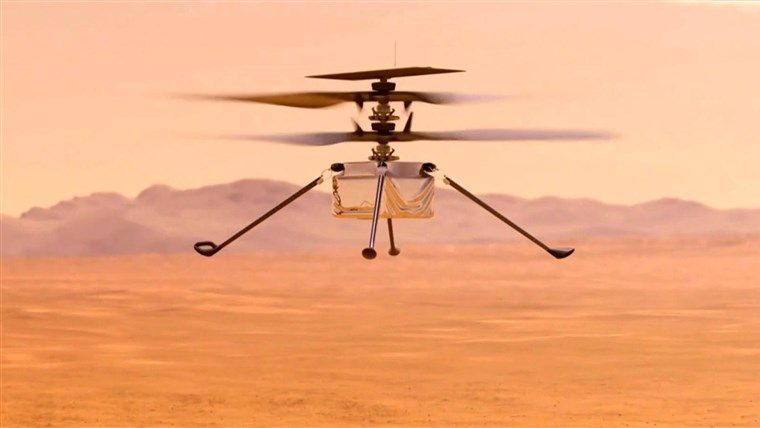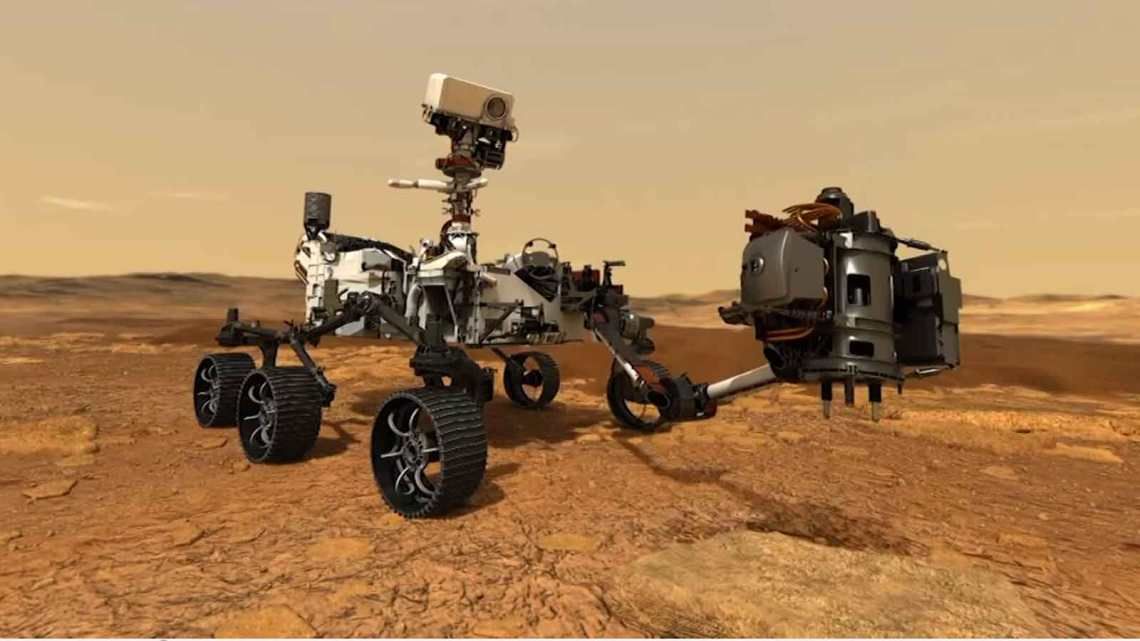Mars Helicopter Goes the Distance in Third Flight
Article by Mike Wall April 25, 2021 (space.com)
• On February 18th, NASA’s Perseverance rover along with the Ingenuity helicopter landed together inside the 28-mile-wide Jezero Crater on Mars. On April 3rd, the small helicopter deployed from the rover’s belly, kicking off a month-long flight campaign. On April 19th the solar-powered helicopter made its 39-second vertical test flight reaching a maximum altitude of about 16.5 feet. On April 22nd, Ingenuity repeated the initial test, but stayed aloft for nearly 52 seconds while moving side-to-side a total of 13 feet. NASA receives the Ingenuity helicopter’s communications data through the Perseverance rover which is relayed to Jet Propulsion Laboratory (JPL) mission control in Pasadena, California.
• On April 25th, the four pound Ingenuity helicopter reached the same 16.5 feet altitude, but increased its airspeed from 0.5 meters per second to 2 meters per second (about 4.5 mph), traveling 164 feet north, then returning to its launch pad, dubbed ‘Wright Brothers Field’. Officials at NASA’s JPL mission control tweeted: “Third flight in the history books.” “ The space chopper is demonstrating critical capabilities that could enable the addition of an aerial dimension to future missions to Mars & beyond.”
• The Ingenuity helicopter mission proves that aerial exploration is possible on Mars. Although Mars has an atmosphere only 1% as dense as that of Earth at sea level, Mars helicopters could serve as scouts on future Red Planet missions, and also gathering data themselves. But this time, Ingenuity is not doing any science work. It is only attempting to demonstrate that it can fly. Ingenuity does carry a 13-megapixel color camera to snap photos of the Perseverance rover’s tire tracks on Mars.
• The JPL ‘Ingenuity team’ hopes to get in two more flights by early May. These last two sorties will likely be “really adventurous,” Ingenuity project manager MiMi Aung said during a news conference earlier this month, stressing that she and her colleagues want to push the little chopper’s limits. Then that will be it for Ingenuity. Perseverance will then begin to focus on the rover’s own science mission with two main tasks: hunting for signs of ancient Mars life inside the Jezero crater, which hosted a lake and river delta long ago; and collecting samples to return to Earth at a later time.

Make it a hat trick on the Red Planet for NASA’s Mars helicopter Ingenuity.
The 4-lb. (1.8 kilograms) chopper aced its third-ever Martian flight early this morning (April 25), adding to its already impressive resume.
“Third flight in the history books.” officials at NASA’s Jet Propulsion Laboratory in Southern California wrote on Twitter. “Our #MarsHelicopter continues to set records, flying faster and farther. The space chopper is demonstrating critical capabilities that could enable the addition of an aerial dimension to future missions to Mars & beyond.”

And today’s sortie was significantly more complex than Ingenuity’s previous two

flights, which took place on Monday (April 19) and Thursday (April 22), respectively. On its historic, 39-second debut hop — the first powered, controlled flight for an aircraft on a world beyond Earth — the solar-powered helicopter went straight up and down and reached a maximum altitude of about 16.5 feet (5 meters).
Ingenuity went about that high on flight number two but stayed up for nearly 52 seconds and moved side-to-side a total of 13 feet (4 m).
“For the third flight, we’re targeting the same altitude, but we are going to open things up a bit, too, increasing our max airspeed from 0.5 meters per second to 2 meters per second (about 4.5 mph) as we head 50 meters (164 feet) north and return to land at Wright Brothers Field,” Ingenuity chief pilot Håvard Grip, of NASA’s Jet Propulsion Laboratory (JPL) in Southern California, wrote in a blog post Friday (April 23). (The Ingenuity team named the chopper’s flight zone after aviation pioneers Wilbur and Orville Wright.)
3:08 minute video of rover and helicopter video footage of Mars (‘Mars Mission’ YouTube)
FAIR USE NOTICE: This page contains copyrighted material the use of which has not been specifically authorized by the copyright owner. ExoNews.org distributes this material for the purpose of news reporting, educational research, comment and criticism, constituting Fair Use under 17 U.S.C § 107. Please contact the Editor at ExoNews with any copyright issue.



